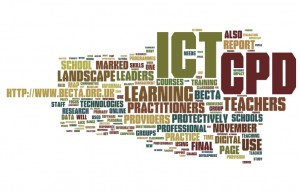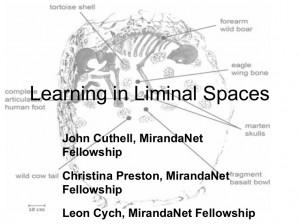
Summary
This ICT CPD Landscape study reports on Information and Communications Technology (ICT) Continuing Professional Development (CPD) programmes available to teachers in England in 2010. Data collection took place in the Autumn of 2009. Although the project findings are based on some desk-based research, the findings are mainly derived from primary data collection through traditional interviews, questionnaires and focus groups.
One outcome of the project, derived on the basis of an experimental methodology, a remotely authored digital domain map, loosely represents the prevailing ICT CPD Landscape. This mapping method was used to ascertain the value of mapping to conceptualise complex domains such as ICT CPD. The map was intended to capture and aggregate perceptions of the landscape held by representatives of the following groups: researchers and providers of, experts and teachers in and leaders receiving ICT CPD. As such the map is invariably subjective.
The map has three branches: Climate focusing on socio-cultural and technological as well as policy factors at local, national and international levels that impact on ICT CPD Provision; Supply plotting providers; and Demand mapping stakeholders, influential groups of professionals, both formally and informally constituted. It has to be noted, though, that these sub-domains are increasingly overlapping.
On the Demand side, this study investigated the opinions of 60 practitioners, 20% of whom were reluctant to use digital technologies in classrooms. 40 informants were ICT CPD leaders in schools. 30 providers were chosen to represent all the key categories identified in the domain map on the Supply side.
In terms of methodology, the project used largely qualitative data collection methods: 90 questionnaire responses were supplemented with in-depth individual and some focus group interviews. Given the small sample size of 130 the findings need to be treated with caution and should be viewed as emerging trends.
The findings are discussed in relation to five categories: providers, leaders, practitioners, field forces and some general observations about the market.
Providers felt they were limited in their provision by market conditions. As a result they were rarely in a position to lead schools into new areas or challenge school priorities. The market is also small and uncertain because schools do not have ringfenced funds for CPD in general and ICT CPD in particular. A wide disparity was noted between individual teacher’s technical skills and competence among those who attended training.
The main means of advertising courses was via fliers, emails to schools, course brochures, and newsletters. Very few Providers used online advertising or social networking sites, although they noted that a number of teachers found out about their courses via word of mouth.
28% of respondents reflected on the need for changed leadership priorities at school and government level also mentioning the loss of ICT advisers as a critical factor in the lack of ICT CPD now taking place. School management or agendas were the most frequently mentioned drivers of ICT CPD. This was followed by government and Local Authority policies; 23% of the sample of provider training focused on software without apparent reference to learning outcomes or teacher confidence.
Most providers referred to the necessity of accommodating school needs even if the provider identified other strategies.
The type, number of courses and number of participants varied across the group. LAs were most consistent offering half to full days, series of sessions and in-school CPD. Some Providers had a group maximum – this occurred mainly within commercial respondents while others take whoever attends. Course content is overwhelmingly about skills and ICT in classrooms, i.e. on the curriculum application of the technology rather than pedagogy. Apart from university provision there are limited opportunities to consider wider issues such as pedagogy or change management.
There was consensus that supply cover and funding had become major factors impacting on teachers being able to attend courses, their ability to learn or to find uninterrupted time to develop what they had learnt. Many providers saw the future for CPD in blended learning, i.e. online, self-directed and face-to-face models.
Most providers have a Mission statement or Vision that they link to the evaluation of course objectives. However, the overall quality and breadth of provision could seemingly be improved if more robust evaluation were undertaken, focusing particularly on relevance to classroom practice and change management.
Techniques such as evaluation by outcomes are also seemingly in need of strengthening.
The providers identified two new directions for ICT CPD: a change from skills training to strategies around the embedding of ICT and an increase in influence of face-to face conferences, educational blogs and micro-blogging such as Twitter.
The majority of leaders found out about CPD opportunities via their LA or through their own initiative, primarily searching online or though professional networking.
Leaders tended to promote CPD opportunities via informal colleague networks or by passing information to certain staff members who they felt would benefit. The selection of CPD programmes for staff appears to be based on an assessment of needs although it was not always clear what form this needs analysis takes. The cost and time required for training as well as the location were frequently given as factors in deciding which CPD to undertake. They were also cited as barriers preventing ICT CPD from being undertaken. Leaders also suggested the refusal of some senior management to see the benefits of ICT CPD as a barrier.
Leaders described a significant move towards in-house ICT CPD provision, provision through communities of practice and learning informally using Web 2.0 applications.
The majority of ICT CPD leaders consider themselves to have high levels of skill in the application of digital technologies. A few leaders of ICT CPD in schools suggested that they are not receiving enough CPD at a high enough intellectual level to deal with the dangers and demands that digital technologies can present. These few leaders also wanted provision that focuses on the innovative pedagogical opportunities that digital technologies offer, the management of change and media issues. Some leaders also thought that some senior management teams might do more to tackle the issues that make teachers reluctant to use ICT in classrooms.
Practitioners complained about the lack of entitlement to CPD in general and seemingly a number of in-house CPD leaders appear to be ignoring the desire of some practitioners to pursue formal qualifications through external courses as a career enhancement move. More practitioners than leaders expressed a keenness to learn and to belong to communities of practice in order to fulfil this learning desire.
Linked with this interest in informal learning, practitioners stated that the most effective CPD they had attended varied enormously. Several cited the face-to-face and online meeting through professional communities and micro-blogging as being good forms of CPD.
Some practitioners felt that issues about the use of digital technologies in classrooms were not being addressed by providers or leaders ranging from reliability problems to concerns about e-safety, unreliable equipment and web services, poor support services, ethical and moral concerns, poor pedagogical practices and fears about social isolation, lowering achievement and celebrating limited achievements too highly. Many of the teachers who are reluctant to use digital technologies in classrooms said they would welcome more professional debate at a higher intellectual level about the role of digital technologies in education and more evidence about their effectiveness as well as discussions about good practice.
External factors impacting on ICT CPD delivery. Five factors were identified on the basis of the study of background literature and baseline data; these were validated by the primary data gathered:
•the availability of external courses to meet individual and institutional needs;
•staff expertise within institutions to provide in-house CPD;
•robust ICT infrastructure and support;
•the length and timing of ICT CPD offerings;
•leadership and vision.
A number of additional factors were identified that had not emerged strongly from the baseline data but were mentioned by the participants who were most active in seeking out opportunities for their own learning:
•professional e-communities of practice;
•informal CPD networks run by teachers’ professional organisations;
•personal Learning Networks, maintained through services such as Twitter and the Blogosphere.
In addition some factors that were identified as constraints were policy and funding driven. These were:
•dedicated time for CPD: teacher tiredness in twilight sessions was cited by providers, leaders and practitioners;
•the lack of a national framework for CPD;
•no compulsion for schools to provide appropriate CPD;
•funding issues;
•CPD being driven by perceived current needs, rather than long-term strategy.
Overall the findings raise questions about how the CPD in ICT Landscape might be defined beyond 2010. The patterns emerging suggest a far more decentralised, informal and fragmented picture than had been the case in the past. The varied offering by providers and the diverse background and training of the trainers make it difficult to evaluate the impact of existing programmes. Limited rigour in evaluation of provision increased the challenge of identifying relevant and challenging course content and effective ICT CPD models.
There exists a concentration of effort into programmes about skills and curriculum applications. Harder to find are courses that link classroom applications to pedagogy, underpinning theories of learning, ICT management and the management of change.
The mismatch between supply and demand appears partly to be caused by the lack of availability and funding for high-level training for providers and leaders and a lack of understanding at senior management level about how digital technologies best be deployed through school development plans in terms of pedagogy and management infrastructure.
Some groups of school practitioners do not have the support of their schools to pursue their own professional development because of the time and cost involved.
Others complain that existing ICT CPD programmes do not meet all their needs. A few early adopters amongst these professionals elect to join national and international communities of practice to improve their informal learning opportunities – largely online.
In this context, the most significant insights appear to be around the growing ‘selfhelp’ agenda. As leaders and practitioners have become more self reliant, more schools have begun to manage their ICT CPD agendas in-house which points to even more fragmentation of the factors and field forces in this area in the future.
The trend towards fragmentation of the ICT CPD landscape shows no slowing down. On the contrary, there appears to be a growth in informal learning opportunities organised and directed by practitioners themselves. These fledgling grassroots developments can, perhaps, be harnessed to enrich more formal ICT CPD provision.
Recommendations
Entitlement to professional learning
Entitlement to professional learning in general should be a priority for practitioners and leaders. In the ICT field, it was felt courses should include coverage of eassessment and evaluation as well as covering matters such as classroom application, subject pedagogy, underpinning theories of learning, ICT management and the management of change. Importance was attached, in addition, to entitlement to professional learning about educational issues such as e-safety and filtering for technical staff and network managers.
Most providers, leaders and practitioners asked for national policy and guidance that identifies protected, dedicated time for teachers, leaders, senior managers to attend, participate in and/or develop continuing professional development in the field of ICT.
Consideration might also be given to funding personal CPD budgets for teachers separate from the school’s CPD budget. Support for informal communities of practice might be one cost-effective way to increase the amount, relevance and immediacy of ICT CPD that can be offered online in a professional context significantly.
Some requested national CPD framework prompts that would emphasize the value of informal personal learning networks as a means of learning and recognise that online events should be accommodated and recognised within a new framework.
Evaluation and assessment of professional development and learning
The evidence collected suggests that the evaluation of CPD programmes needs to be improved including the incorporation of methods that measure impact on achievement over time. Providers should be encouraged to undertake robust evaluation of their provision, focusing particularly on relevance to, and impact on classroom practice and change management. More thought should be given to the potential role of digital technologies in assessment, including making use of the multimodal and collaborative affordances of digital technologies.
Senior management issues
Concerns about the lack of value accorded to ICT CPD by some senior managers might be addressed by provision of leadership courses that cover questions of theory, ethics, pedagogy, the integration of ICT in learning processes and change management as well as issues associated with running a network. Senior managers it seems also need to ensure the reliability of equipment in school in order to enable staff to be more comfortable using ICT in classrooms.
Support for schools
In order to extend and develop ICT CPD input through groups such as ASTs and SiPs, relevant case studies should be developed that exemplify good practice. ASTs and similar groups might be offered relevant CPD opportunities that develop their potential as multipliers.
Provision for an overarching national online community of practice
Social learning online over a sustained period of time appears to be an effective way of learning about how to use ICT for teaching and learning. Therefore, the development of an overarching national online community of practice providing a one-stop shop for access to informal and formal CPD and expert providers might be a useful way of harnessing increasingly fragmented individual endeavours.
Improving ICT CPD Provision
Based mainly on the data gathered from providers the following recommendations can be made:
- That policy and guidance identifies protected, dedicated time for teachers to attend, participate in and develop continuing professional development.
- That funding supports dedicated time for teacher’ CPD. Consideration could be given to funding for teachers’ personal budgets discrete from a school’s CPD budget.
- That providers undertake robust evaluation of their provision, focusing particularly on relevance to classroom practice and change management and, where possible, that they follow up evaluation of outcomes.
- That more courses go beyond acquiring technical skills and focus on pedagogical practice as well and that they also include strategic and pedagogical considerations. Provision of courses with relevance to management should also be safeguarded.
Qualitative research methodologies
The use of digital concept maps was found to provide an effective means of collaborative conceptualising of a complex domain across a distributed group of experts and other informants. Researchers may wish to consider the use of concept mapping for data the collection of perceptual data.
Authors
Norbert Pachler, Christina Preston, John Cuthell, Allison Allen, Catrin Pinheiro-Torres
Read the full report
The full report is also available online from the WLE Centre, Institute of Education, University of London.
Becta material is © Crown copyright, 2010.
You may use and re-use the Becta material featured on this website (not including logos) free of charge in any format or medium, under the terms of the Open Government Licence.
Video and photography can only be re-used if it is maintained in its original state and used for its original purpose.
Any re-used material must carry the following attribution, adjusted to the context for files, quotes, etc.
This material was originally published by Becta or its predecessor organisations and has been made available under the Open Government Licence.
Any re-purposing of this material must carry the following attribution:
This material has been developed from publications produced by Becta or its predecessor organisations which was made available under the Open Government Licence.
Any enquiries regarding the use and re-use of this information resource should be sent to e-mail:psi@nationalarchives.gsi.gov.uk





